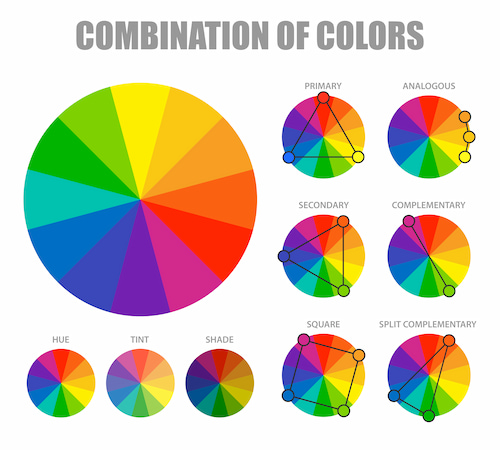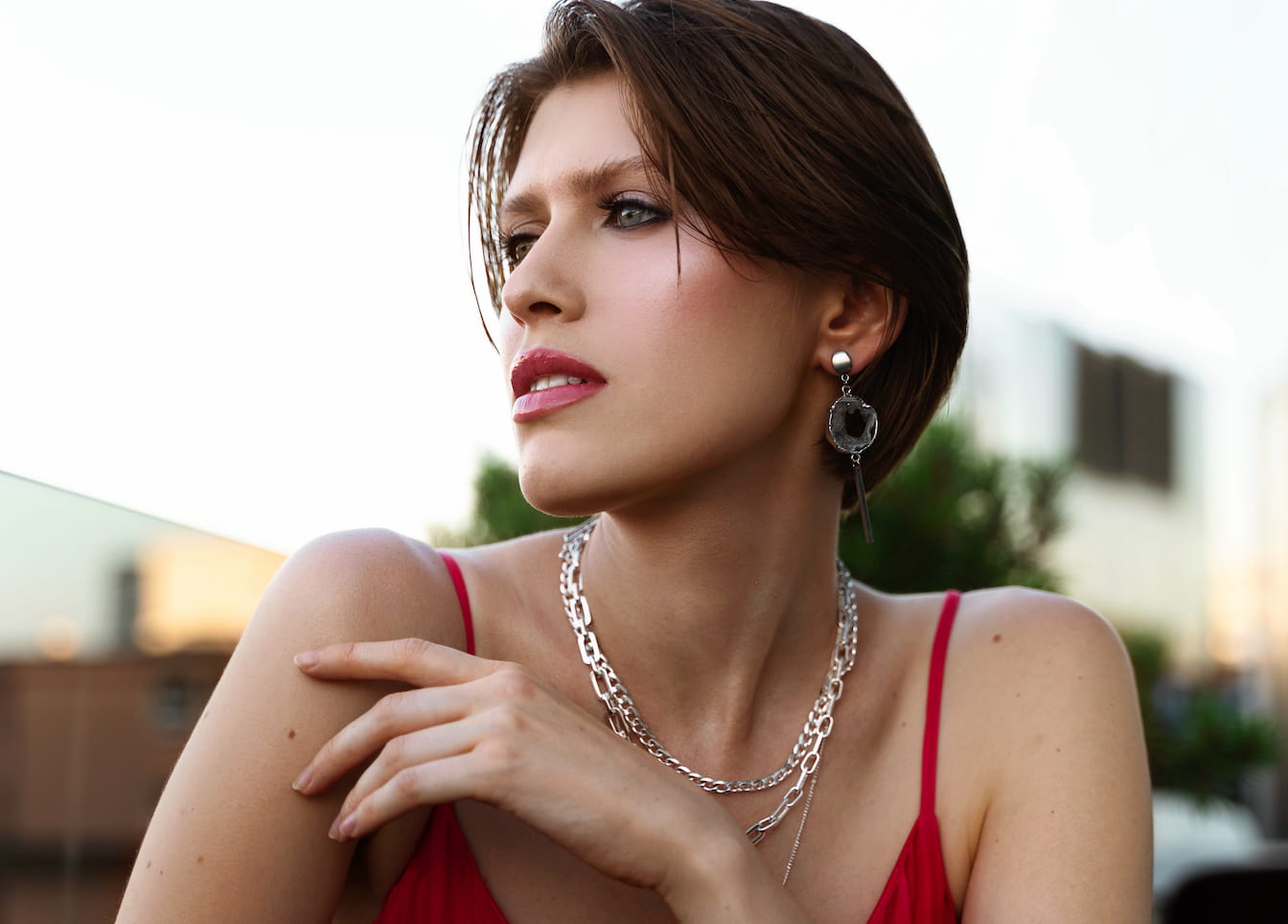Choosing the right jewelry can significantly enhance your overall appearance, but finding the perfect piece can feel overwhelming with so many styles, materials, and colors available. If you are asking "What color jewelry should I wear?", it's not just about personal preference but an interplay of your skin undertones and outfit coordination.
This guide delves into the colorful world of jewelry, employing principles of color theory and an understanding of your skin undertones, wardrobe, and the latest trends to help you make informed choices. Read on to ensure your jewelry choices are always on point!

Basic Principles of Color Theory
Understanding the basics of color theory is key when deciding the right color jewelry to wear. Here are some fundamental principles of color theory relevant to jewelry:
Color Wheel Basics
The color wheel visually represents the relationships between different hues. It consists of primary colors (red, yellow, and blue), secondary colors (green, orange, and purple), and tertiary colors (created by mixing primary and secondary colors). In fashion, the wheel helps identify harmonious color combinations, such as:
Analogous Colors: Colors that sit next to each other on the wheel, like yellow, yellow-green, and green, create a harmonious and calming look.
Complementary Colors: Opposites on the color wheel, like blue and orange, provide striking contrast and make each other pop.
Triadic Colors: A set of three evenly spaced colors, such as red, yellow, and blue, offer a vibrant and balanced palette.
Warm vs. Cool Tones:
Colors are broadly categorized into warm and cool tones:
Warm Colors: Include reds, oranges, and yellows, conveying energy and warmth. Warm-toned jewelry, like gold, brass, and copper, pairs well with warmer skin undertones and outfits in warm colors.
Cool Colors: Include blues, greens, and purples, offering a calming effect. Cool-toned jewelry, like silver, white gold, and platinum, complements cooler skin undertones and outfits in cool colors.
What Are the Commonly Used Colors in Jewelry?
Jewelry comes in a dazzling array of colors, allowing you to express your style and personality effortlessly. Here are the most commonly used colors in jewelry:
Gold: Gold jewelry is timeless and versatile, coming in three popular shades: yellow gold with its warm and luxurious tone, white gold with a silvery-white appearance, and rose gold with a distinctive pinkish hue.
Silver: Silver jewelry remains a staple for many. Sterling silver (92.5% pure) offers a cool-toned, bright finish, while fine silver, nearly pure, has a striking white appearance.
Platinum: Platinum is a rare and precious metal known for its bright, cool-toned finish. Its silvery appearance provides a modern yet classic look.
Gemstones: Gemstone jewelry offers a spectrum of vibrant colors.
Diamond: Clear or with subtle color variations.
Ruby: Deep red.
Sapphire: Most commonly blue but available in various colors.
Emerald: Vibrant green.
Amethyst: Rich purple hues.
Citrine: Golden-yellow shades.
Turquoise: Distinctive blue-green hues.
Alternative Metals and Materials: Alternative metals and materials provide unique textures and colors. Stainless steel, with its sleek and industrial look, offers a modern silver tone. Titanium and tungsten are lightweight and strong, available in shades from silver to black. For contemporary styles, wood, resin, and acrylic provide colorful and unconventional options.
How Do You Know Your Skin Undertone?
When choosing what color jewelry to wear, understanding your skin undertone is key. Here's how you can identify your skin undertone:
Vein Color: Assess the underside of your wrist under natural light. Green or yellow veins denote warm undertones, while blue or purple veins indicate cool undertones. A mix suggests neutral undertones.
Sun Reaction: Observe how your skin responds to sunlight. Easy tanning typically suggests warm undertones. Conversely, quick pinkness or burning hints at cool undertones, often associated with paler skin.
White Clothing Preference: Your favored clothing colors offer clues. If creamy or off-white shades complement you more than stark white, you likely have warm undertones. If both work equally well without washing you out, neutral undertones are probable.
Eyes and Hair: While less straightforward, eye and hair colors can provide hints. Blue, grey, or green eyes and ash blonde, brown, or black hair often align with cool undertones. Warm undertones are often reflected in brown, amber, or hazel eyes, and red, black, or golden blonde hair.
What Jewelry Color Suits Your Skin Best?
Now that you recognize your skin undertone, here's a guide to help you identify which jewelry colors suit your skin best:
Cool Undertones
Colors: Silver, platinum, white gold, and other metals with a silver hue are ideal for cool undertones. These colors will harmonize with the natural blueish or pinkish hues of your skin.
Gemstones: Opt for gems that are blue, purple, or have cool shades like sapphires, amethysts, aquamarines, and diamonds. Pearls also look stunning, especially white and silver-toned pearls.
Example Styles: A sleek platinum bracelet or a sterling silver necklace adorned with a sapphire pendant can enhance your natural glow without overwhelming it.
Warm Undertones
Colors: Gold tones, such as yellow gold, rose gold, copper, and brass, are perfect for warm undertones. These metals bring out the warmth in your skin and create a radiant look.
Gemstones: Choose stones like rubies, citrines, garnets, or amber that exhibit warm colors. Yellow or orange gemstones can also accentuate the golden hues of your skin.
Example Styles: A delicate rose gold chain or a bold yellow gold ring studded with a citrine can add a touch of warmth and elegance to your ensemble.
Consider Your Outfit
Besides your skin undertone, it's essential to also consider the colors and style of your outfit when decide on the color of your jewelry. Here are some tips to help you choose jewelry that complements your attire:
Match Metals with Clothing Colors
Silver, Platinum, and White Gold: These cool-toned metals complement cooler-colored outfits like blues, purples, grays, and blacks. They also work well with white and pastel shades.
Yellow Gold, Rose Gold, and Copper: Warm metals are best suited for earth tones like browns, oranges, yellows, and olive greens. They also complement warmer shades like red and burgundy.
Mixed Metals: For a versatile approach, mix and match silver, gold, and rose gold jewelry. This adds dimension to your outfit and pairs well with outfits in neutral shades like beige, white, and black.
Contrast or Complement
Contrast: Make your jewelry stand out by contrasting it with your outfit. For example, a bold gold necklace can pop against a black dress, while turquoise earrings can contrast beautifully with a white blouse.
Complement: Choose jewelry that complements your outfit's color palette. If you're wearing a navy dress, opt for sapphire or silver jewelry to maintain a cohesive look.
Outfit Patterns
Solid Colors: With solid-colored outfits, you have more freedom to experiment with bold and patterned jewelry. A plain dress is a perfect canvas for a vibrant, multi-colored necklace or layered bracelets.
Busy Patterns: If your outfit features intense patterns or multiple colors, choose simpler, more subdued jewelry. A single-color gemstone ring or a pair of classic hoop earrings can complement without competing.
Seasonal Color Trends
Staying on top of seasonal color trends is a fantastic way to keep your jewelry choices fresh and in the mood. Here's a guide to seasonal color trends:
Spring: Think of soft pastels and lively, nature-inspired hues that embody the rebirth and vibrancy of spring. Floral designs and light-colored gemstones such as rose quartz, aquamarine, and moonstone fit beautifully with spring's theme of renewal. Silver and white gold complement the bright and airy feel of spring fashion.
Summer: Summer is all about bright, energetic colors that reflect the warmth and joy of the season. Turquoise, coral, and amber pieces reflect the season's warmth. Consider chunky, colorful bracelets or statement necklaces that stand out with summer's lighter clothing.
Autumn: As the leaves change, autumn brings a warm, earthy palette that feels rich and comforting. Gemstones like amber, garnet, citrine, and tiger's eye perfectly reflect fall foliage. Yellow gold, bronze, and copper jewelry add to the autumnal warmth. Darker stones like smoky quartz, onyx, and deep green emeralds complement the season's hues.
Winter: Winter offers a mix of cool tones and festive, shimmering accents that capture the magic of the season. Icy blue sapphires, bright white diamonds, and deep blue lapis lazuli resonate with the cold. Add some glitz with metallics like platinum, silver, and rhodium, paired with festive gems like rubies and emeralds. White gold and silver pair well with the winter palette, adding a subtle shine.
Conclusion
As we've learned, the answer to the question "What color jewelry should I wear?" should be based on a thoughtful process that takes into account your skin undertone, outfit, and the latest seasonal trends. By applying the basic principles of color theory and understanding your skin's undertones, you can select jewelry that truly complements you. Whether you opt for the timeless elegance of gold, the cool allure of silver, or the bold statement of colorful gemstones, make sure it resonates with your personal style and enhances your natural beauty.
FAQ
How do I know if I should wear gold or silver?
Consider your skin undertone: warm tones pair well with gold, while cool tones favor silver. Neutral undertones can wear both metals with versatility. You can also consider the colors of your wardrobe: gold pairs well with earthy colors, while silver complements cooler tones and black and white outfits.
What color jewelry matches everything?
Silver and gold jewelry are classic choices that match virtually every outfit. Silver adds a sleek, modern touch, while gold provides a warm, timeless look. Additionally, clear gemstones like diamonds and pearls are versatile options that match well with all colors.
Does silver or gold look more classy?
Both silver and gold can look classy, depending on your style and preference. Silver often has a sleek, modern appeal, while gold exudes warmth and luxury. Ultimately, the choice between silver and gold comes down to your personal taste, the occasion, and what complements your outfit best.




